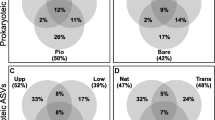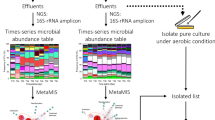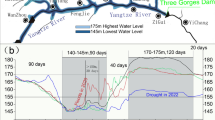Abstract
Functional redundancy in bacterial communities is expected to allow microbial assemblages to survive perturbation by allowing continuity in function despite compositional changes in communities. Recent evidence suggests, however, that microbial communities change both composition and function as a result of disturbance. We present evidence for a third response: resistance. We examined microbial community response to perturbation caused by nutrient enrichment in salt marsh sediments using deep pyrosequencing of 16S rRNA and functional gene microarrays targeting the nirS gene. Composition of the microbial community, as demonstrated by both genes, was unaffected by significant variations in external nutrient supply in our sampling locations, despite demonstrable and diverse nutrient-induced changes in many aspects of marsh ecology. The lack of response to external forcing demonstrates a remarkable uncoupling between microbial composition and ecosystem-level biogeochemical processes and suggests that sediment microbial communities are able to resist some forms of perturbation.
Similar content being viewed by others
Log in or create a free account to read this content
Gain free access to this article, as well as selected content from this journal and more on nature.com
or
References
Allison SD, Martiny JBH . (2008). Resistance, resilience, and redundancy in microbial communities. Proc Natl Acad Sci USA 105: 11512–11519.
Bagwell CE, Lovell CR . (2000). Persistence of selected Spartina alterniflora rhizoplane diazotrophs exposed to natural and manipulated environmental variability. Appl Environ Microbiol 66: 4625–4633.
Biddle JF, Fitz-Gibbon S, Schuster SC, Brenchley JE, House CH . (2008). Metagenomic signatures of the Peru Margin subseafloor biosphere show a genetically distinct environment. Proc Natl Acad Sci USA 105: 10583–10588.
Bowen JL, Crump BC, Deegan LA, Hobbie JE . (2009). Increased supply of ambient nitrogen has minimal effect on salt marsh bacterial production. Limnol Oceanogr 54: 713–722.
Braker G, Fesefeldt A, Witzel KP . (1998). Development of PCR primer systems for amplification of nitrite reductase genes (nirK and nirS) to detect denitrifying bacteria in environmental samples. Appl Environ Microbiol 64: 3769–3775.
Brin LD, Valiela I, Goehringer D, Howes B . (2010). Nitrogen interception and export by experimental salt marsh plots exposed to chronic nutrient. Mar Ecol Prog Ser 400: 3–17.
Bulow SE, Francis CA, Jackson GA, Ward BB . (2008). Sediment denitrifier community composition and nirS gene expression investigated with functional gene microarrays. Environ Microbiol 10: 3057–3069.
Crump BC, Peterson BJ, Raymond PA, Amon RMW, Rinehart A, McClelland JW et al. (2009). Circumpolar synchrony in big river bacterioplankton. Proc Natl Acad Sci USA 106: 21208–21212.
Deegan LA . (2002). Lessons learned: the effects of nutrient enrichment on the support of nekton by seagrass and salt marsh ecosystems. Estuar Coasts 25: 727–742.
Deegan LA, Bowen JL, Drake D, Fleeger JW, Friedrichs CT, Galván KA et al. (2007). Susceptibility of salt marshes to nutrient enrichment and predator removal. Ecol Appl 17: S42–S63.
Fuhrman JA, Hewson I, Schwalbach MS, Steele JA, Brown MV, Naeem S . (2006). Annually reoccurring bacterial communities are predictable from ocean conditions. Proc Natl Acad Sci USA 103: 13104–13109.
Fuhrman JA, Steele JA, Hewson I, Schwalbach MS, Brown MB, Green JL et al. (2008). A latitudinal diversity gradient in planktonic marine bacteria. Proc Natl Acad Sci USA 105: 7774–7778.
Galand PE, Casamayor EO, Kirchman DL, Lovejoy C . (2009). Ecology of the rare microbial biosphere of the Arctic Ocean. Proc Natl Acad Sci USA 106: 22427–22432.
Galloway JN, Townsend AR, Erisman JW, Bekunda M, Cai Z, Freney JR et al. (2008). Transformation of the nitrogen cycle: recent trends, questions, and potential solutions. Science 320: 889–892.
Hamersley MR, Howes BL . (2005). Coupled nitrification-denitrification measured in situ in a Spartina alterniflora marsh with a 15NH4+ tracer. Mar Ecol Prog Ser 299: 123–135.
Hopkinson CS, Giblin AE . (2008). Nitrogen dynamics of coastal salt marshes. In: Capone D, Bronk D, Mulholland M, Carpenter E (eds.), Nitrogen in the Marine Environment. Elsevier: Oxford, pp. 931–1036.
Howes BL, Howarth RW, Teal JM, Valiela I . (1981). Oxidation-reduction potentials in a salt marsh: spatial patterns and interactions with primary production. Limnol Oceanogr 26: 350–360.
Huber JA, Mark Welch DB, Morrison HG, Huse SM, Neal PR, Sogin ML . (2007). Microbial population structures in the deep marine biosphere. Science 318: 97–100.
Huse SM, Dethlefsen L, Huber JA, Mark Welsh DB, Relman DA, Sogin ML . (2008). Exploring microbial diversity and taxonomy using SSU rRNA hypervariable tag sequencing. PLoS Genet 4: e1000255.
Huse SM, Huber JA, Morrison HG, Sogin ML, Mark Welch DB . (2007). Accuracy and quality of massively parallel DNA pyrosequencing. Gen Biol 8: R143.
Huse SM, Mark Welch DB, Morrison HG, Sogin ML . (2010). Ironing out the wrinkles in the rare biosphere through improved OTU clustering. Environ Microbiol 12: 1889–1898.
Jayakumar A, Naqvi SWA, Ward BB . (2009). Distribution and relative quantification of key genes involved in fixed nitrogen loss from the Arabian Sea oxygen minimum zone. In: Hood, RR (ed.), Indian Ocean Biogeochemical Processes and Ecological Variability. American Geophysical Union, pp. 187–203.
Koop-Jakobsen K, Giblin AE . (2009). Anammox in tidal marsh sediments: the role of salinity, nitrogen loading, and marsh vegetation. Estuar Coasts 32: 238–245.
Koop-Jakobsen K, Giblin AE . (2010). The effect of increased nitrate loading on nitrate reduction via denitrification and DNRA in salt marsh sediments. Limnol Oceanogr 55: 789–802.
Kunin V, Engelbrektson A, Ochman H, Hugenholtz P . (2009). Wrinkles in the rare biosphere: pyrosequencing errors lead to artificial inflation of diversity estimates. Environ Microbiol 12: 118–123.
Lovell CR, Bagwell CE, Czákó M, Márton L, Piceno YM, Ringerling DB . (2001). Stability of a rhizosphere microbial community exposed to natural and manipulated environmental variability. FEMS Microbiol Ecol 38: 69–76.
Osterman LE, Poore RZ, Swarzenski PW . (2008). The last 1000 years of natural and anthropogenic low oxygen bottom water on the Louisiana Shelf Gulf of Mexico. Mar Micropaleo 66: 291–303.
Paerl HW . (1997). Coastal eutrophication and harmful algal blooms: importance of atmospheric deposition and groundwater as ‘new’ nitrogen and other nutrient sources. Limnol Oceanogr 42: 1154–1165.
Rabalais NN, Turner RE, Wiseman WJ . (2002). Gulf of Mexico hypoxia: AKA, ‘The Dead Zone’. Ann Rev Ecol Syst 33: 235–263.
Rappé MS, Giovannoni SG . (2003). The uncultured microbial majority. Ann Rev Microbiol 57: 369–394.
Sogin ML, Morrison HG, Huber JA, Mark Welch DB, Huse SM, Neal PR et al. (2006). Microbial diversity in the deep sea and the underexplored ‘rare biosphere’. Proc Natl Acad Sci USA 103: 12115–12120.
Tyler AC, Mastronicola TA, McGlathery KJ . (2003). Nitrogen fixation and nitrogen limitation of primary production along a natural marsh chronosequence. Oecologia 136: 431–438.
Valiela I, Foreman K, LaMontagne M, Hersh D, Costa J, Peckol P et al. (1992). Couplings of watersheds and coastal waters: sources and consequences of nutrient enrichment in Waquoit Bay, Massachusetts. Estuaries 15: 443–457.
Valiela I, Teal JM, Cogswell C, Hartman J, Allen S, Van Etten R et al. (1985). Some long-term consequences of sewage contamination in salt marsh ecosystems. In: Godfrey PJ, Kaynor, ER, Pelczarski S, Benforado J (eds), Ecological Considerations in Wetlands Treatment of Municipal Wastewaters. Reinhold Co: New York, pp. 301–316.
Valiela I, Teal JM, Sass WJ . (1973). Nutrient retention in salt marsh plots experimentally enriched with sewage sludge. Estuar Coast Mar Sci 1: 261–269.
Valiela I, Teal JM, Sass WJ . (1975). Production and dynamics of salt marsh vegetation and the effects of experimental treatment with sewage sludge. J Appl Ecol 12: 973–981.
Ward BB, Eveillard D, Kirshtein JD, Nelson JD, Voytek MA, Jackson GA . (2007). Ammonia-oxidizing bacterial community composition in estuarine and oceanic environments assessed using a functional gene microarray. Environ Microbiol 9: 2522–2538.
Zumft WG . (1997). Cell biology and molecular basis of denitrification. Microbiol Mol Biol Rev 61: 533–616.
Acknowledgements
Funding for this research came from NSF (DEB-0717155 to JEH, DBI-0400819 to JLB). Support for the sequencing facility came from NIH and NSF (NIH/NIEHS-P50-ES012742-01 and NSF/OCE 0430724-J Stegeman PI to HGM and MLS, and WM Keck Foundation to MLS). Salary support provided from Princeton University Council on Science and Technology to JLB. Support for development of the functional gene microarray provided by NSF/OCE99-081482 to BBW. The Plum Island fertilization experiment was funded by NSF (DEB 0213767 and DEB 0816963). The original Great Sippewissett marsh fertilization experiment was a collaboration between I Valiela and John Teal. Brian Howes and Dale Goehringer maintained the fertilization of the Great Sippewissett plots in recent years. Recent funding for maintenance of the Great Sippewissett Marsh Plots came from NSF (OCE-0453292, DEB-0516430 to IV). We would like to thank anonymous reviewers for constructive feedback on earlier versions of this manuscript.
Author information
Authors and Affiliations
Corresponding author
Ethics declarations
Competing interests
The authors declare no conflict of interest.
Additional information
Supplementary Information accompanies the paper on The ISME Journal website
Supplementary information
Rights and permissions
About this article
Cite this article
Bowen, J., Ward, B., Morrison, H. et al. Microbial community composition in sediments resists perturbation by nutrient enrichment. ISME J 5, 1540–1548 (2011). https://doi.org/10.1038/ismej.2011.22
Received:
Revised:
Accepted:
Published:
Issue date:
DOI: https://doi.org/10.1038/ismej.2011.22
Keywords
This article is cited by
-
Rare and localized events stabilize microbial community composition and patterns of spatial self-organization in a fluctuating environment
The ISME Journal (2022)
-
Functional plasticity in oyster gut microbiomes along a eutrophication gradient in an urbanized estuary
Animal Microbiome (2021)
-
Effects of mixed coniferous and broad-leaved litter on bacterial and fungal nitrogen metabolism pathway during litter decomposition
Plant and Soil (2020)
-
Contrasting Water Quality Treatments Result in Structural and Functional Changes to Wetland Plant-Associated Microbial Communities in Lab-Scale Mesocosms
Microbial Ecology (2020)
-
Nutrient Enrichment Alters Salt Marsh Fungal Communities and Promotes Putative Fungal Denitrifiers
Microbial Ecology (2019)



